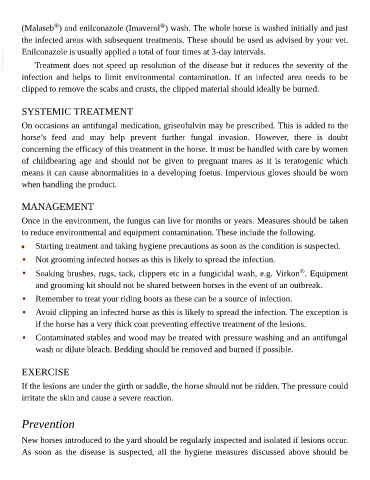Page 818 - The Veterinary Care of the Horse
P. 818
®
®
(Malaseb ) and enilconazole (Imaverol ) wash. The whole horse is washed initially and just
the infected areas with subsequent treatments. These should be used as advised by your vet.
VetBooks.ir Enilconazole is usually applied a total of four times at 3-day intervals.
Treatment does not speed up resolution of the disease but it reduces the severity of the
infection and helps to limit environmental contamination. If an infected area needs to be
clipped to remove the scabs and crusts, the clipped material should ideally be burned.
SYSTEMIC TREATMENT
On occasions an antifungal medication, griseofulvin may be prescribed. This is added to the
horse’s feed and may help prevent further fungal invasion. However, there is doubt
concerning the efficacy of this treatment in the horse. It must be handled with care by women
of childbearing age and should not be given to pregnant mares as it is teratogenic which
means it can cause abnormalities in a developing foetus. Impervious gloves should be worn
when handling the product.
MANAGEMENT
Once in the environment, the fungus can live for months or years. Measures should be taken
to reduce environmental and equipment contamination. These include the following.
• Starting treatment and taking hygiene precautions as soon as the condition is suspected.
• Not grooming infected horses as this is likely to spread the infection.
®
• Soaking brushes, rugs, tack, clippers etc in a fungicidal wash, e.g. Virkon . Equipment
and grooming kit should not be shared between horses in the event of an outbreak.
• Remember to treat your riding boots as these can be a source of infection.
• Avoid clipping an infected horse as this is likely to spread the infection. The exception is
if the horse has a very thick coat preventing effective treatment of the lesions.
• Contaminated stables and wood may be treated with pressure washing and an antifungal
wash or dilute bleach. Bedding should be removed and burned if possible.
EXERCISE
If the lesions are under the girth or saddle, the horse should not be ridden. The pressure could
irritate the skin and cause a severe reaction.
Prevention
New horses introduced to the yard should be regularly inspected and isolated if lesions occur.
As soon as the disease is suspected, all the hygiene measures discussed above should be

